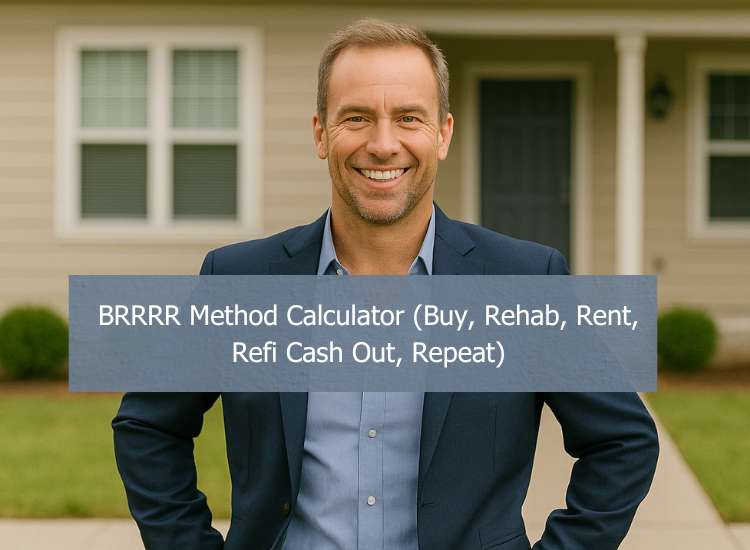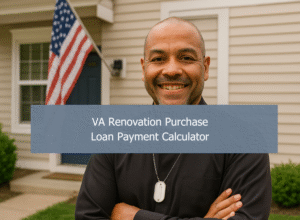How to Use the BRRRR Method to Build Long-Term Wealth Through Real Estate
- By Jim Blackburn
- on
- Tags: Calculators, New Construction, Spec Homes

If you’re a real estate investor or aspiring to become one, the BRRRR method—Buy, Rehab, Rent, Refinance, Repeat—is a powerful way to grow your rental portfolio while recycling your initial capital. Let’s break down how it works, step-by-step, using a real-world example and explore how a BRRRR Method Calculator can guide your decisions with clarity and confidence.
Step 1: Buy
Initial Purchase Example:
Purchase Price: $250,000
Renovation Budget: $50,000
Total Investment: $300,000
When acquiring a property using the BRRRR method, the goal is to buy below market value. A distressed or undervalued property gives you room to add equity through renovations. You can pay cash, use a renovation loan, or finance the purchase traditionally with a down payment. For example, a 3% down payment on a $250,000 home is just $7,500, but keep in mind that closing costs (estimated at 6%) will add to your cash outlay.
With no seller credit or assistance, the total out-of-pocket might be around $22,500. However, if you negotiate a 3% seller credit and secure down payment assistance, your upfront cost could shrink to just $7,500.
Step 2: Rehab
Estimated After Repair Value (ARV): $400,000
The renovation phase is where you unlock the value. Smart improvements—kitchen, bath upgrades, structural fixes, curb appeal—help drive up the ARV. Once completed, your newly improved home is re-appraised to determine its updated market value. In our example, the $300,000 investment becomes a $400,000 asset, giving you $100,000 in new equity.
Step 3: Rent
Post-Renovation Rental Income: TBD
Now, the goal is to secure tenants and begin generating monthly rental income. This income can help offset your monthly mortgage payments, taxes, insurance, and other costs. Ideally, your property becomes cash flow positive, but even break-even properties can be worthwhile due to appreciation and tax advantages. If you’re not cash flowing yet, this phase helps you evaluate rental potential and market rates.
Step 4: Refinance
New Loan Based on ARV (80% of $400,000): $320,000
New Monthly Housing Expense: $2,617
Cash Out: $64,700
Once rented, you can apply for a cash-out refinance using the new appraised value. Lenders typically allow you to borrow up to 75–80% of ARV. In this case, 80% of $400,000 equals $320,000. From this new loan, you can pay off the original acquisition loan and pocket the difference—over $64,000 in tax-deferred cash. This cash can then be used to fund your next BRRRR deal, essentially recycling your original down payment and renovation costs.
Step 5: Repeat
With your cash back in hand, you’re ready to find your next deal. This is the heart of the BRRRR method—building a portfolio with velocity. Each cycle builds more equity, rental income, and long-term appreciation while leveraging the same initial investment multiple times.
Important Considerations
- If your monthly expenses exceed your rental income (as in the example: -$2,617 monthly cash flow), it’s crucial to analyze whether this property should be held or sold post-renovation.
- You may consider reducing your refinance amount, increasing rents, or selecting a different property.
- Always evaluate the terms of any Down Payment Assistance (DPA) programs, which may limit your ability to refinance or sell in the early years.
- Consult with a mortgage expert to tailor your strategy to your goals, credit profile, and local market.
Final Thoughts
The BRRRR strategy isn’t just a buzzword—it’s a blueprint for wealth building through real estate. By using a BRRRR Method Calculator, you can simulate various property scenarios, test cash flow outcomes, and plan your next move with confidence. With the right strategy, team, and diligence, your first BRRRR deal could be the start of a long, prosperous investment journey.
Ready to Start?
Get preapproved for your BRRRR Method investment plan and schedule a free consultation with our experienced mortgage team. Let’s help you leverage wisely and grow wealthy—one property at a time.
Ready to Take Your First Step?
Skip the guesswork. Take our quick Discovery Quiz to uncover your top financial priorities, so we can guide you toward the wealth-building strategies that fit your life.
- 💡 Takes just 5 minutes
- 📊 Tailored results based on your answers
- 🔒 No credit check required
Need a Pre-Approval Letter—Fast?
Buying a home soon? Complete our short form and we’ll connect you with the best loan options for your target property and financial situation—fast.
- 💡 Only 2 minutes to complete
- 📊 Quick turnaround on pre-approval
- 🔒 No credit score impact
Got a Few Questions First?
Let’s talk it through. Book a call and one of our friendly advisors will be in touch to guide you personally.
Schedule a CallImportant Disclaimer
This calculator is for illustrative purposes only and does not constitute financial, legal, or investment advice. Results are based on general assumptions and may not reflect actual performance or eligibility. This is not a loan estimate or approval. Please consult with a licensed mortgage advisor before making financial decisions.



